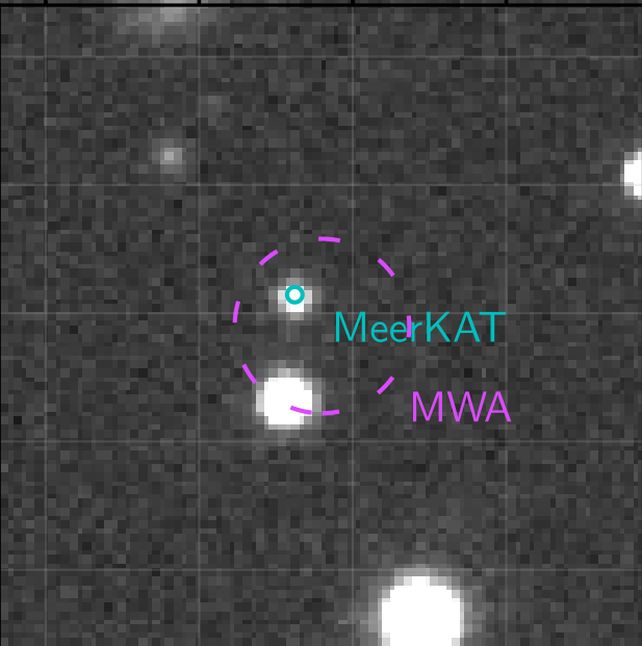Products You May Like
A few years ago, a radio telescope operating out of the desert of Western Australia observed something very weird.
Just 4,000 light-years from Earth, something was emitting a bright radio signal like nothing we’d ever seen before: flashing like a pulsar, but with a super long period between pulses, and a super long pulse itself. The nature of the source was impossible, at that point, to discern.
So astronomers went looking for answers – and found another one, coming from 15,000 light-years away. It, too, was difficult to pinpoint amid the crowded region of space from which it emanated.
Now they’ve found a third, around 5,000 light-years away. This one has the longest period yet, emitting flashes between 30 and 60 seconds long, every 2.9 hours – and astronomers have narrowed it down to a single source that finally could tell us what makes these curious emissions: a tiny, red dwarf star in a binary orbit with an even tinier white dwarf star.
“The long-period transients are very exciting, and for astronomers to understand what they are, we need an optical image. However, when you look toward them, there are so many stars lying in the way that it’s like 2001: A Space Odyssey. ‘My god, it’s full of stars!’,” says astrophysicist Natasha Hurley-Walker of the Curtin University node of the International Centre for Radio Astronomy Research (ICRAR) in Australia.
“Our new discovery lies far off the Galactic Plane, so there are only a handful of stars nearby, and we’re now certain one star system, in particular, is generating the radio waves.”
The so-called long-period transients came to widespread attention in 2022, when astronomers reported the discovery of a flashing signal in archival data from the Murchison Widefield Array (MWA), a powerful telescope operating in low radio frequencies. It was called GLEAM-X J162759.5−523504.3, and was recorded emitting radio waves for 30 to 60 seconds, every 18.18 minutes, up until March 2018 when it stopped.
The second signal, reported in 2023, was discovered in follow-up MWA observations. In a different, but still crowded, part of the sky, something was found emitting five-minute bursts of radio waves every 22 minutes. A look at archival data found it had been active since at least 1988. That was GPM J1839-10.
One type of star that emits pulsing signals is a type of neutron star called a pulsar, the collapsed core of a massive star that has gone supernova. Pulsars emit beams of radio waves as they spin, so that they appear to flash as we watch them; but pulsar flashes are never that slow, occurring on timescales of seconds to milliseconds.
The third signal, named GLEAM-X J0704-37 is very similar. It was found in MWA archival data, too, emitting a signal lasting 30 to 60 seconds, every 2.9 hours. But it’s in a much less crowded region of space, the outskirts of the Milky Way in the southern constellation of Puppis.

This meant the researchers had a better shot at identifying the precise source of the signals. They used the MeerKAT radio telescope array in South Africa to zoom in on the patch of sky from which the signal originated, and found only one faint star that matched the location. An analysis of the star’s spectrum revealed its identity: an M-type red dwarf.
Now, red dwarfs are legion in the Milky Way. They constitute the most numerous category of stars in the galaxy. If a normal red dwarf could just spit out the long-period radio emission we see from GLEAM-X J0704-37, then we’d probably be seeing a lot more of them doing it. This suggests that there’s something unusual about GLEAM-X J0704-37; something that is difficult to see.
That something, the team thinks, is most likely a white dwarf, the collapsed remnant core of a dead sun. These ultra-dense objects have masses up to 1.4 Suns, packed into a sphere somewhere between the size of Earth and the Moon.
“The M dwarfs are low-mass stars that have a mere fraction of the Sun’s mass and luminosity. They constitute 70 per cent of the stars in the Milky Way, but not one of them is visible to the naked eye,” Hurley-Walker says.
“Our data suggests that it is in a binary with another object, which is likely to be a white dwarf, the stellar core of a dying star. Together, they power radio emission.”
frameborder=”0″ allow=”accelerometer; autoplay; clipboard-write; encrypted-media; gyroscope; picture-in-picture; web-share” referrerpolicy=”strict-origin-when-cross-origin” allowfullscreen>
According to the team’s calculations, the binary could consist of a red dwarf star around 0.32 times the mass of the Sun, and a white dwarf 0.8 times the mass of the Sun. If the two are in a close enough orbit, the white dwarf could be accreting material from the red dwarf; this process could result in constant beams of emission from the white dwarf’s poles.
We can’t see the beams, but as they lash the red dwarf, they could be causing it to temporarily brighten, as seen in the binary system AR Scorpii.
The next step will be to conduct further observations, in both radio and ultraviolet wavelengths, to try to find direct evidence for the white dwarf. If confirmed, that would make GLEAM-X J0704-37 a white dwarf pulsar – one of the rarest kinds of stars in the Milky Way.
The team’s research has been published in The Astrophysical Journal Letters.
